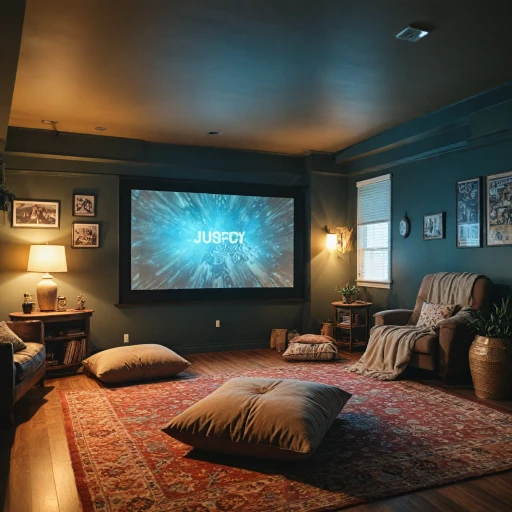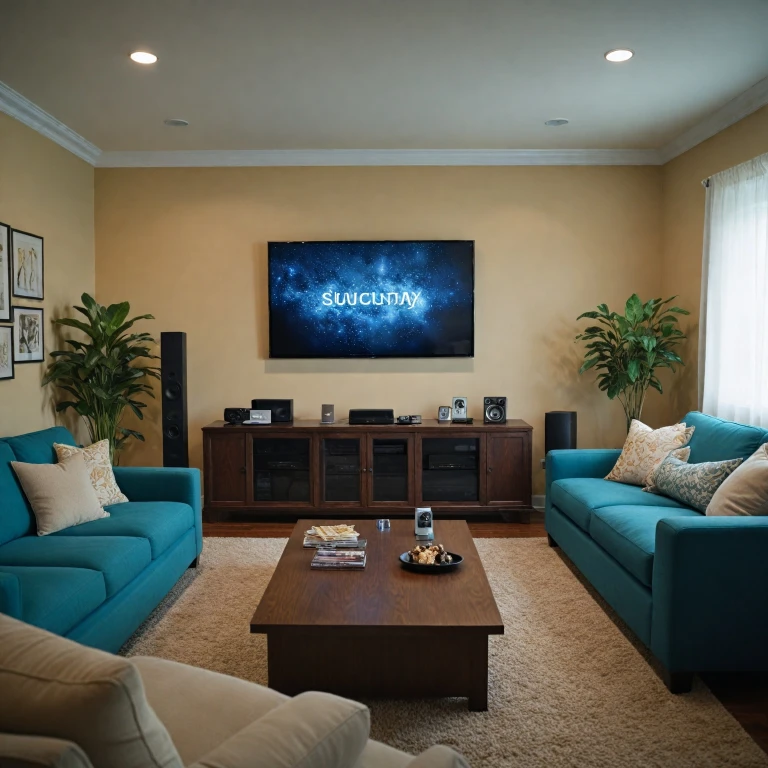Understanding Wireless HDMI Technology
Exploring the Foundations of Wireless Connectivity in Home Theaters
Understanding how wireless HDMI technology revolutionizes home theater setups begins with grasping its core components: the transmitter, receiver, and the HDMI extender. These elements collectively eliminate the need for long, unsightly cables running across your room, providing a clean and modern look.
Wireless HDMI systems connect your HDMI video source — like a Blu-ray player or gaming console — with your projector without the need for physical cables. Essentially, your HDMI video is transmitted wirelessly from a transmitter connected to the source to a receiver connected to the projector. This wireless video setup is often referred to as a “plug-and-play” system, emphasizing its easy setup process with minimal interference.
These systems are particularly advantageous when it comes to portability and maintaining picture quality over considerable distances, or long range. Regular price barriers have been lowered over time with more frequent online sales allowing consumers to find options at a sale price that suits most budgets. Platforms like Amazon offer a wide array of products such as the Nyrius Aries kit, which is lauded for its high-quality picture and reliable connectivity.
However, there are aspects to consider closely, such as the effective range and any potential interference with your existing home network. Transmitters and receivers might be disrupted by large obstructions or electronic signals from other devices, so selecting a product with a robust connection is crucial to maintaining optimal performance.
If you're interested in delving deeper into the specifics of how each component fits within your home theater system, understanding the role of different connectors can be invaluable. Check out this
resource on various cable interfaces that might enhance your setup efficiency further. As technology evolves, we can expect these systems to become even more seamlessly integrated with advanced home entertainment solutions, ensuring an immersive viewing experience.
Benefits of Using a Wireless HDMI Transmitter
Unlocking the Advantages of Wireless HDMI Transmitters
Wireless HDMI transmitters have become indispensable tools in elevating the home theater experience. Imagine the convenience of connecting your projector without the clutter of cables running across your living room floor. This not only enhances the aesthetics of your space but also simplifies the setup process, making it incredibly user-friendly.
One of the primary benefits is the seamless video and audio transmission. With models like the Nyrius Aries, you can expect impressive picture quality that truly compliments your HD projector. From Blu-ray movies to high-definition gaming, the ability to transmit HDMI video wirelessly means you enjoy the freedom of flexible device placement in any room.
Furthermore, the range of these transmitters can be quite impressive. Many systems offer long-range capabilities, allowing you to comfortably place devices at a considerable distance without compromising on quality. This is especially useful for larger rooms or when your devices are not in direct line of sight.
Cost is another element to consider. Though the regular price of wireless HDMI kits can vary, often there's a sale price available on platforms like Amazon. Evaluating factors like the distance of transmission and any additional features such as usb support is crucial for value.
Many systems adopt a plug-and-play approach, meaning they are as simple as connecting a box, plugging in the transmitter and receiver, and powering up. This user-centric design means you don’t have to be a tech expert to set up your home theater system.
Lastly, the portability of options available, such as portable wireless kits or HDMI extenders, provides more flexibility for different setups. Whether you're looking to create an indoor cinema or want a portable solution for outdoor viewing, there's an HDMI wireless solution tailored for you.
For a comprehensive guide on selecting the right in-wall HDMI cable to further optimize your setup, check
The Essential Guide to Choosing the Right In-Wall HDMI Cable for Your Home Theater Projector. Keep in mind the aim is to complement your wireless HDMI system with reliable cable solutions when needed.
Choosing the Right Wireless HDMI Transmitter for Your Projector
Picking the Perfect Wireless HDMI Transmitter
Selecting the right wireless HDMI transmitter for your projector involves considering several key factors. These options can make a significant difference in the picture quality and overall viewing experience in your home theater.
First, ensure compatibility with your existing devices. Not all transmitters may work with your specific projector, video sources such as Blu-ray players, or receivers. Look for models like the Nyrius Aries which are known to be compatible with a range of devices including HD and 4K projectors.
Range and Coverage
Contemplate the size and layout of your room. A long-range transmitter is crucial if you require a reliable signal over a greater distance, especially in large rooms. Some popular models have ranges extending up to 100 feet. Consider a model that meets your distance needs without sacrificing clarity.
Picture Quality and Resolution
Resolution is another key consideration. Opt for units that support high-definition resolutions (HDMI output) such as 1080p or even 4K, ensuring that your video transmitter does not compromise the picture quality. This is crucial for maintaining a cinema-like experience with clear and vivid images.
Ease of Installation and Use
Seek out plug-and-play systems that minimize the need for additional setup or technical expertise. Features like USB power, HDMI output, and easy-to-install HDMI cables simplify the process. Portable wireless HDMI kits offer flexibility for installations that may require frequent adjustments.
Price and Warranty
Review the regular price and sale price variations across different platforms like Amazon, balancing them with your budget. Investing in a mid-range model often offers a good balance of quality and affordability. Also, check warranty options provided by the manufacturer to ensure peace of mind in case of defects or issues.
Additional Features
Consider additional features such as wireless video receiver kits and HDMI extenders for those with extensive systems. These extras can enhance the overall functionality of your setup.
Finally, staying informed on the latest tech digital innovations and future trends in wireless HDMI solutions can help you make educated decisions. You can
explore these innovations further to ensure your home theater system stays updated and performs optimally.
Installation Tips for a Seamless Setup
Steps to Achieve a Flawlessly Functional Setup
Setting up your wireless HDMI system can be straightforward if approached correctly. By following a methodical sequence, you ensure optimum performance with minimal effort.
Firstly, identify the appropriate position for both your HDMI transmitter and receiver. Place them within a clear line of sight for optimal signal transmission. This placement is crucial for achieving maximum range, especially in large rooms or spaces with multiple devices.
When handling connectivity, it's important to start by connecting the HDMI transmitter to your video source, such as a Blu-ray player or gaming console. Use a high-quality HDMI cable to secure this connection. The transmitter then wirelessly sends the designated video output to the receiver, connected to your projector or TV.
Power is another vital consideration. Ensure both the transmitter and receiver are powered on using their respective power adapters, often included in the receiver kit. Modern devices typically employ a plug and play system, making the initial setup virtually hassle-free. Some models may also support USB power, allowing for a more portable wireless setup.
To double-check the connection, navigate through the settings menu on your projector to select the correct HDMI input source. Once synced, the picture quality should match, optimizing both audio and visual experiences.
Moreover, integrating tech digital enhancements can further elevate your experience. Take advantage of available functions such as HDMI extender capabilities if you need long range coverage. By doing so, you ensure that your entire home theater system functions seamlessly, without physical limitations imposed by standard cables.
Finally, if you encounter any connectivity issues, reviewing troubleshooting advice can remedy common problems quickly. Regular maintenance and occasional software updates may also enhance your wireless system's performance. Adapting to evolving trends in wireless HDMI technology ensures sustained satisfaction at an accessible price point, whether you invest in brands like Nyrius Aries or compare sale price options on platforms like Amazon.
Troubleshooting Common Issues
Troubleshoot Like a Pro with These Helpful Tips
Even with the best wireless HDMI transmitters, issues can occasionally arise. Here are some common problems you might encounter and solutions to get your system back on track:
- Intermittent Signal Drops: If your video transmitter is experiencing sporadic signal loss, consider examining the range and any potential obstructions in the room. The presence of thick walls or electronic interference can impede performance. Ensure the line of sight between the transmitter and receiver is as open as possible.
- Poor Picture Quality: While modern systems boast excellent picture quality, issues can still crop up. Check the connection integrity of your HDMI cable from your blu-ray player or other devices to the transmitter. Sometimes, simply reseating the plug can resolve the problem.
- Sync Issues: Some users experience challenges with audio syncing when using a wireless HDMI setup. If you face this, a quick power cycle of both the transmitter and receiver - by unplugging and then plugging them back in - can often rectify the issue.
- Compatibility Problems: Ensure your devices are compatible with each other; for instance, pairing a Nyrius Aries system with older models might require checking for software updates or consulting tech digital resources for assistance.
- Transmitter Kit Not Working: If your wireless video kit appears dead, examine the USB or power connections, ensuring they're secure. If it's still under warranty, consider returning it for a replacement or reaching out to Amazon for support if purchased through them.
Don't forget, checking the user manual included in your purchase box can provide additional instructions tailored to your specific model. When issues persist, professional guidance might be necessary to ensure your transmitter receiver setup operates smoothly.
Future Trends in Wireless HDMI Technology
The Evolution and Future of Wireless HDMI Technology
As technology continues to advance at a rapid pace, it's becoming clear that the world of home theater systems is moving toward more seamless, wireless solutions. Wireless HDMI technology plays a pivotal role in this evolution, offering users unparalleled convenience and flexibility.
Looking to the future, we can expect a number of exciting developments in wireless HDMI technology:
- Enhanced Range and Signal Stability: As demand grows, manufacturers are likely to focus on extending the range and improving the signal stability of HDMI transmitters. This means you'll be able to enjoy high-quality video streaming even in larger rooms or when the signal needs to travel through walls or other obstacles.
- Improved Picture Quality: The focus on enhancing picture quality will continue, with new systems aiming to support higher resolutions like 8K. This will ensure that the experience of watching movies or playing games is more vivid and immersive.
- Cost-Effectiveness and Accessibility: As with most technology, the price of wireless HDMI transmitters is expected to decrease over time, making them accessible to a wider audience. This will likely be coupled with sales and discounts on platforms such as Amazon, where you can often find popular models such as the Nyrius Aries.
- Compact and Portable Designs: With an increasing number of people opting for minimalist setups, portable wireless HDMI systems that are sleek and compact are becoming more popular. These designs allow for easy setup and transportation, providing flexibility for various room configurations.
- Integration with Other Smart Devices: Expect more integration with smart home ecosystems. Future wireless HDMI kits may come with USB connectivity and better plug-and-play capabilities, allowing seamless interaction with other smart devices, ultimately creating a more connected home.
These advancements point towards a future where high fidelity and ultra-portability become the standard for wireless video setups. The continuous innovation within the tech digital sphere ensures that both enthusiasts and everyday users can look forward to an increasingly rich home theater experience.

